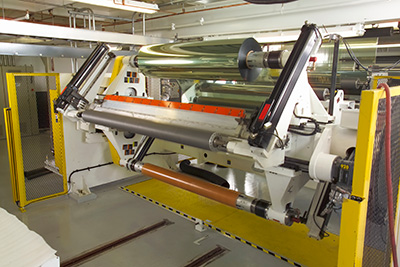Efficiency in Winding and Unwinding
- Published: September 14, 2020

By Dan Hould, Product Manager – Winding and Unwinding, Davis-Standard, LLC
The most essential part of winding and unwinding efficiency is tension control. Tension control is a highly dynamic process across the entire line starting with the unwind all the way to the winder. The following are a few suggestions relative to unwind and winder that contribute to best practices:
Unwind
- Match the speed of a new roll to the line speed via sensors and control logic;
- Track the location of the splice from unwind to winder as it progresses through the various converting stages (factoring in variables such as speed, length, time, etc.);
- Employ a core detect feature to minimize residual web on expiring roll;
- Simplify incoming product roll splice preparation to ensure consistent splice position and repeatable tail lengths;
- Use paster roll technology with an electro-mechanical firing mechanism to minimize paster bounce and promote accurate and consistent contact with the product roll; and
- Engage splicing systems with a gap follower/peel roll for products susceptible to blocking.
Winder
- Apply multi-point tension and lay-on loading set points with recipe capability to permit flexibility for different substrates;
- Use process or product specific lay-on systems with gap/contact winding capabilities;
- Automate handling of product rolls,cores and shafting;
- Evaluate a shaftless versus shafted design option based on process to simplify the product and core handling systems;
- Ensure the winder is ergonomically designed for operations;
- Minimize preparation time for quicker cycles; consider tapeless transfer designs; and
- Match the type of cutting blade with the substrate being processed for the winder (a knife for thick or stiff materials such as PET versus a soft flexible film; consider tooth size, material, angle, pitch).
Ensuring Limited Machine Downtime and Waste
Process consistency that prevents missed splices and ensures a successful transfer is the most important best practice to limit downtime and waste. Each missed unwind splice leads to significant downtime because of re-threading the entire machine, cleaning up the line and material waste, and restarting procedures. In order to avoid this, it’s important to understand the process and machine components from unwind to winder. We recommend starting with a holistic design of the entire line to evaluate the performance of each component. Take advantage of the equipment and material knowledge offered by the machine OEM vendor. Having access to a lab to prove the structure and design, as well as component reliability and functionality is highly beneficial. The more you know up front, the better prepared you will be to achieve a quality process and minimized disruption.
Facing the Challenges of Continuous Splicing Techniques for Small Diameter Rolls
One of the primary challenges is the faster response time. For example, the control system has to react quicker because the roll length is shorter. This requires new servo-type paster roll systems and paster covering technology to minimize the bounce. Splicing also has to occur more frequently. In some cases, this requires additional automation to offload spent cores and load new product rolls. With a core detect feature, processors can minimize the residual web on an expiring roll.
The Pros and Cons of Inline Slitting
The pros involve minimizing steps. The slitter-rewinder step is eliminated and there is less handling, which limits the risk of roll damage and waste in the finished product.
The cons involve greater complexity because winding and slitting operations are combined. It is not easy to change to different SKU’s (widths, thicknesses, etc.) because that requires a more extensive set-up change.
Process lines running extensible products are typically more suitable for inline slitting where various widths and diameters are required. A basic center, surface or center/surface winder is used in this case. Rigid products work for inline slitting when slitting requirements are minimal. This requires splitting the product into two or three lanes to allow for a relatively even tension distribution across the sheet, and for products that can be spread via standard systems. Once slitting requirements call for multiple narrow widths requiring differential winding and or a duplex slitter rewinder it is best to stay with conventional off line slitting for the most efficient process.




